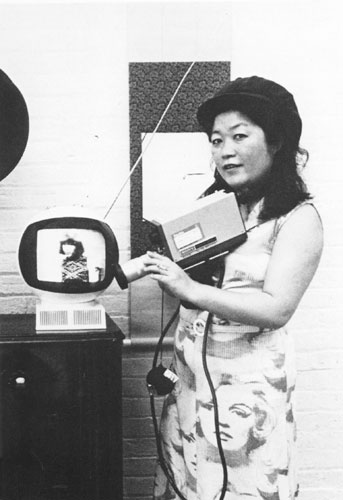Discussione:Shigeko kubota
shigeko kubota (2 agosto 1937 - 23 luglio 2015) è stato un video artista giapponese, scultore e avanguardia artista di performance, che per lo più vissuto a New York City.
Biografia
Shigeko Kubota nasce a Niigata in Giappone, nel 1937. Studia scultura nel suo paese natale fin quando non si trasferisce a New York nel 1964. A New York conosce George Maciunas, il fondatore del movimento artistico Fluxus. Diviene ben presto una figura attiva ed influente del movimento, dove inoltre viene fortemente influenzata soprattutto dalle idee di Marcel Duchamp e John Cage, a cui dedicò il video Marcel Duchamp e John Cage (1972) e la video-scultura Duchampiana: Nude Descending a Staircase (1976). All'interno del movimento, poi, conosce colui che nel 1977 diventerà suo marito: Nam June Paik. Kubota si è esibita nei maggiori musei d'arte moderna di New York e di gran parte del mondo anche in Italia, alla Biennale di Venezia del 1990. Una delle performances più significative e ricordate di Kubota, fu il suo Vagina Painting (1965), che presentò alla Perpetual Fluxus Festival, del New York Cinemateque. I primi video di Kubota riflettono sulle relazioni tra Oriente ed Occidente attraverso costruzioni audiovisive che rimandano ad una forma di diario.
La prima nella serie fu Europe on 1/2 inch a day (1972), una prospettiva molto personale dell'Europa negli anni '70.
Come gli altri video artisti degli anni '70, anche Kubota fu interessata alla manipolazione di immagini elettroniche sintetizzate, come per esempio in Video girls and video songs for Navajo sky (1973). Nel 1972, insieme agli artisti Charlotte Moorman, Susanna Milano e Steina Vasulka, e altri, Kubota ha partecipato al primo video-festival femminile al Kitchen di New Yor
Bibliografia
- Butler, Judith. Bodies that matter: on the discursive limits of "sex". New York: Routledge. 1993.
- Butler, Judith. Gender trouble: feminism and the subversion of identity. New York: Routledge. 1990.
- Butler, Judith. Undoing gender. New York: Routledge. 2004.
- Cross, Lowell. "Reunion": John Cage, Marcel Duchamp, Electronic Music and Chess". Leonardo Music Journal. 9: 1999. 35-42.
- Gever, M. "Pressure Points: Video in the Public Sphere," Art Journal 45.3, 1985.
- Gewen, Barry. "State of the Art". New York Times. 2005.
- Goldberg, RoseLee. Performance: live art since 1960. New York: Harry N. Abrams Publishers. 1998.
- Jacob, Mary Jane ed. Shigeko Kubota: Video Sculpture. New York: American Museum of the Moving Image, 1991. Includes: Roth, Moria, "The Voice of Shigeko Kubota:' A Fusion of Art and Life, Asia and America,'" and Hanley, JoAnn, "Reflections in a Video Mirror."
- Mark, Lisa, WACK! Art and the Feminist Revolution. Cambridge, MA: MIT Press. 2007.
- O'Dell, Kelly, Fluxus Feminus, MIT Press (TDR) Vol. 41. No. 1, 1997. 43-60.
- Ruhrberg, Karl; Honnef, Klaus; Fricke, Christiane; Manfred Schneckenburger, Ingo F. Walther, Art of the 20th century. Taschen. 2000. 596.
- Sackler, Arthur M. American film. American Film Institute. 24–28. 1980.
- Schneider,Rebecca, The Explicit Body in Performance. New York: Routledge, 1997.
- Smith, Roberta, "Review/Art; Sleek Video Sculptures By Shigeko Kubota". The New York Times. (24 May 1991), 26.
- Stiles, Kristine, “Between Water and Stone: Fluxus Performance, A Metaphysics of Acts,” in Armstrong and Rothfuss, In the Spirit of Fluxus.
- Warr, Tracey, and Amelia Jones. The Artist's Body. London: Phaidon. 2000.
- Yoshimoto, Midori. "Self-exploration in Multimedia : the Experiments of Shigeko Kubota," in Into performance: Japanese Women Artists in New York. New Brunswick, N.J., Rutgers University Press. 2005.
